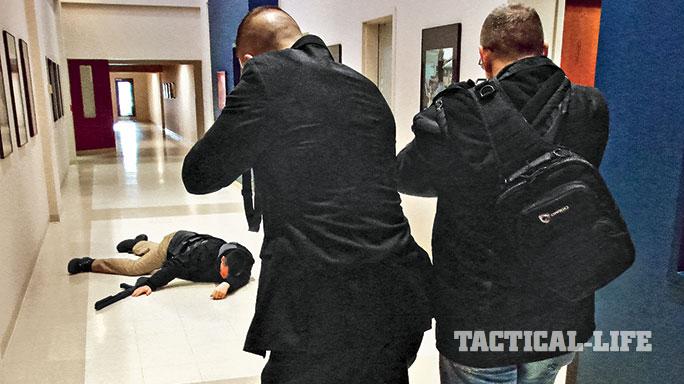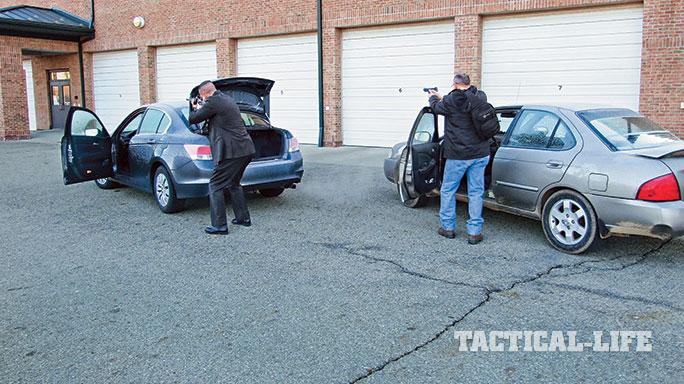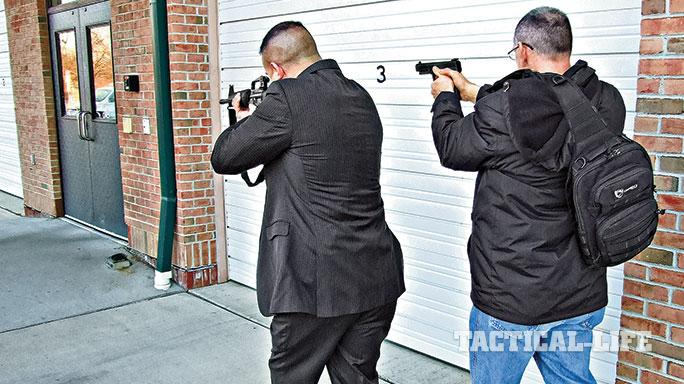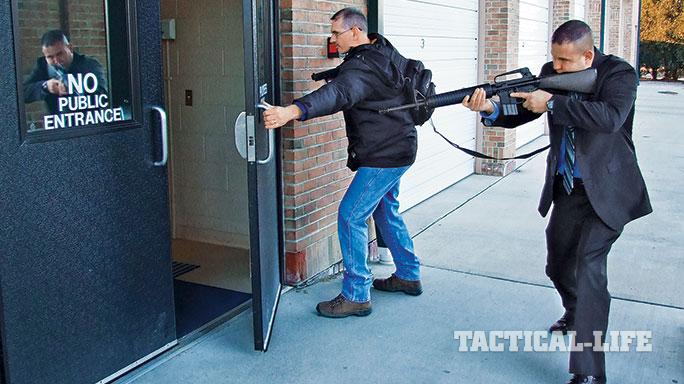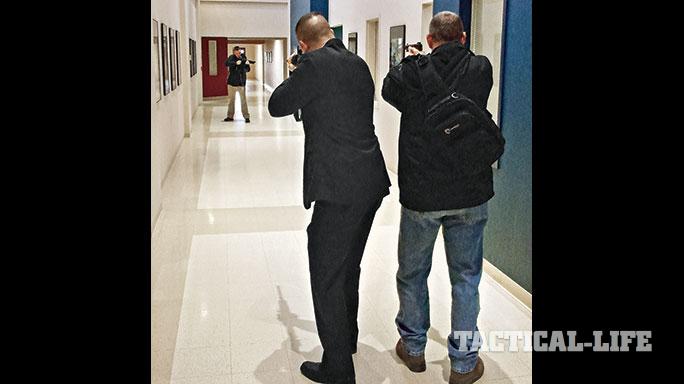We spend a lot of time discussing, writing about and training for active-shooter events in our jurisdictions.
These activities are tremendously important and have led to a positive evolution of the techniques and strategies involved in stopping or limiting these horrific events. We have gone from waiting for SWAT and treating the situation like a barricade (as was the case in the Columbine incident) with disastrous results, to Quick Unit Action Deployment (QUAD) models that involve forming up a four-officer team immediately upon arrival before SWAT gets there, to the current model of “the first guy there with a rifle goes in.” What is always assumed in these models is that everyone responding will be a uniformed patrol officer. What is not taken into account is the possibility that a plainclothes or off-duty officer will be the first responder.
Advertisement — Continue Reading Below
If we happen upon an active-shooter event, or have one unfolding around us, we must take action—there is no other choice. We need to be prepared in advance to take the safest, most effective action that we can.
Packing Heat
Our ability to respond is impossible if we don’t faithfully carry off-duty firearms—and that means everywhere in public where there is no overriding local authority in control that prevents it. For law enforcement officers, those places are generally few and far between, but they do exist, so be aware of them.
Advertisement — Continue Reading Below
Otherwise, when I say everywhere, I mean everywhere. That includes church—a place where up until 10 years ago or so, I didn’t feel the need to carry. There was a time when even the worst of criminals would not dare offend in a church sanctuary—which is no longer true. Atrocities will be committed anywhere.
While the first rule of a gunfight is to have a gun or guns, there are a few questions that need to be answered about those guns. First, how competent are you with that gun or guns? Have you practiced with them regularly, and at what distances? Can you hit what you are shooting at (in this case, let’s say a human silhouette target) at extended ranges? Can you hit at 50 feet, 25 yards, 50 yards or even 100 yards with your pistol?
Maximum-range pistol shooting is not only possible with practice, but it may be necessary if you have to interdict an active shooter armed with only a handgun. Next, what kind of gun or guns do you carry, or have available to you when you are off-duty or working plainclothes? Micro .380s are great to carry and work well at close ranges. But for most people, getting hits at extended ranges is not only unlikely, but it’s darn near impossible.
Advertisement — Continue Reading Below
If you choose to carry a small off-duty handgun rather than a larger compact like a baby Glock or a mid-size gun, you should have a second, more effective gun available to you to backup your primary off-duty gun.
In my case, my constant-carry off-duty gun is my Smith & Wesson Model 642 Airweight .38 Special five-shot revolver. I am good with this gun out to 50 yards with five out of five solid hits on the silhouette when fired with both hands and standing. At 100 yards, due to the white-on-white fixed sights, that drops to one or two hits out of five just on the paper. In my book, that takes the Model 642 out of the picture as a primary active-shooter response arm unless I find myself suddenly engulfed in an active-shooter incident.
I have long kept an AR-15—specifically a Del-Ton Alpha 220H rifle—secured in the back of my personal pickup truck as my primary active-shooter response arm. I feel that the rifle’s heavy, 20-inch barrel offers better accuracy with iron sights due to the longer sight radius and increases the effectiveness of the 5.56mm NATO round. A lot of my fellow officers also carry some variation of the AR-15 in their vehicles at all times.
Advertisement — Continue Reading Below
There are alternatives to the AR if your agency is one of the few that still does not authorize rifles. Twelve gauge shotguns—pump or auto—when equipped with rifle sights or a capable optic can be quite effective out to 75 or 100 yards when used with rifled slugs. Certainly, being hit with a 1-ounce hunk of lead will certainly get
the attention of anyone bent on the destruction of innocent lives.
Recently, I’ve hit on another alternative—one that is more easily carried, accessed and likely to be available more often—the FN Five-seveN 5.7x28mm pistol. In previous testing, I’ve found that the flat-shooting 5.7x28mm round is capable of not only easy 100-yard hits (six of six solid on the silhouette) but also out to 200 yards, although my average drops to 50 percent or so at that range. In fact, my accuracy with the Five-seveN pistol is better than with the PS90 5.7x28mm carbine due to the crisper, lighter trigger pull.
Advertisement — Continue Reading Below
Weighing in at only 23 ounces unloaded, the Five-seveN holds 21 rounds of nearly recoil-free ammunition whose permanent ballistic cavity rivals Winchester’s 9mm, 127-grain +P+ Ranger load. Carried off-duty in a Drago Gear Sentry Pack with a total of 61 rounds available, I feel confident in my response capabilities with this combo. A new 1,100-lumen Streamlight ProTac HL3 tactical light rides in the pack for emergency illumination. If you are limited on space and permitted to carry a Five-seveN, you too may want to consider it as an option.
Moving In
Good gear isn’t enough. You also need the right mindset. Back when the QUAD model was the primary response methodology, off-duty and plainclothes responses were discouraged due to concerns of blue-on-blue “friendly fire” incidents—and with good reason. However, with the shift to the single-officer emergency response plan of counterattack, an off-duty or plainclothes officer may be the first and only responder available, especially in remote areas. But that doesn’t mean that the danger of a blue-on-blue shooting no longer exists.
Advertisement — Continue Reading Below
At the start of this article, I said that we must provide the safest and most effective response possible, and we have discussed the effectiveness part. This leaves a discussion of safety on the table.
If you did not find yourself caught up in the middle of an active-shooter incident (as did an off-duty state police officer who was dropping his child off at school recently when the event began), but are planning on inserting yourself into the event, a greater measure of caution can be used to avoid blue-on-blue mistakes simply because you have more time to prepare.
Advertisement — Continue Reading Below
In an insertion intervention, several considerations come to mind. Are there other cops there already, and do they need or want your help? I would not run towards such a scene outside my jurisdiction to help with a rifle in hand. In the opening moments when the shooting is still occurring, no one knows or is sure who the shooter is, and anyone in street clothes with a gun in their hands could be the suspect. This is also why the AK-47 is never your gun of choice as a responder in these situations, despite how great a weapon it is. Sadly, it has too often been the gun of choice for the bad guys.
Unless the AK is a department-permitted weapon and you are in your jurisdiction, don’t show up with one. Remember, too, that in the aftermath of all the anti-gun hysteria that followed the Sandy Hook massacre, in many places even the AR-15 is now seen as a bad guy gun as well, so keep it secured until you are identified as a good guy before bringing it into play.
As part of my response gear in my vehicle, I carry a SWAT Level III armored vest with the words “police” plainly marked on the front and rear. Even if I am momentarily mistaken somehow with this gear on, it gives me a chance to survive the mistake. If you don’t have the luxury of, or the funds for, additional armor, consider a tactical vest that is also marked “police” or “sheriff” as a less expensive alternative. Also, if you have a Velcro cloth badge emblem available, stick that on, too.
Advertisement — Continue Reading Below
If you are the very first LEO on the scene, call 911 and let the dispatcher know who you are and that you are going in. Here is the biggest lifesaver of all: If confronted by other police forces, comply immediately. Hit the ground as fast as you can if the command is given or if it seems that someone is about to shoot you, and clear the weapon away from you. Everyone’s nerves are firing beyond Condition Red. Be prepared to take yourself out of the fight instantly before someone else does it for you.
Once you are geared up and going in, remember that the vast majority of the current active-shooter population is nothing but cowardly punks—how else would you categorize someone who would shoot a classroom full of first-grade children with an AR-15 rifle? They fold like a house of cards when confronted by someone with equal or greater firepower who is willing to use that firepower; they usually either surrendering quickly or commit suicide when they hear the responding forces arriving or approaching. Use their cowardice to your advantage.
In another recent school shooting, a school resource officer yelled “Police!” as he ran to the shooter’s position in the school. The shooter killed himself when he heard the officer loudly approaching. His use of verbal identification doubtless saved many lives because it caused the shooter to take appropriate personal action before the SRO could reach him. The Sandy Hook shooter did the same thing. He killed himself when he heard approaching sirens.
These individuals can inflict pain, misery and suffering on others regardless of how young or harmless they are, but they would rather cause their death at their own hands rather than endure what they consider pain and suffering inflicted upon them at the hands of another. So I would make all the law-enforcement-related noise I could when moving towards the shooter in order to trigger a shooter suicide instead of using a silent approach. It has been proven at least twice to work.
In the end, remember that the active shooter is the ultimate bully, and every bully is a coward when someone stands up to them. You need to be that someone. Be prepared, and proceed safely and effectively.
